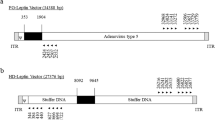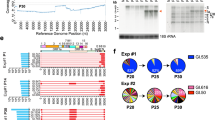Abstract
WE have previously reported that fragments of Simian adenovirus SA7 DNA produced by physical breakage are oncogenic1. These fragments had an average molecular weight corresponding to half-molecules (11.4× 106). After separation of the heavy and light molecular halves by density gradient centrifugation, we demonstrated that both half-molecule preparations retain the ability to initiate tumours in newborn hamsters. We suggested that this may be caused by the presence of one or more “oncogenic regions” in both molecular halves, or by random breaks near the centre of the DNA which could result in a single small oncogenic region, residing near the centre and occurring with equal probability in either the heavy or light half-molecule preparation. To clarify these results we have studied the effect of several restriction endonucleases on the oncogenic activity of SA7 DNA. These enzymes produce defined fragments of the SA7 genome rather than the heterogeneous populations produced by physical shear.
This is a preview of subscription content, access via your institution
Access options
Subscribe to this journal
Receive 51 print issues and online access
$199.00 per year
only $3.90 per issue
Buy this article
- Purchase on Springer Link
- Instant access to full article PDF
Prices may be subject to local taxes which are calculated during checkout
Similar content being viewed by others
References
Mayne, N., Burnett, J. P., and Butler, L. K., Nature new Biology, 232, 182–183 (1971).
Burnett, J. P., Summers, A. O., Harrington, J. A., and Dwyer, A. C., Appl. Microbiol., 16, 1245–1250 (1968).
Yoshimori, R. N., thesis, Univ. Calif., San Francisco (1971).
Smith, H. O., and Wilcox, K. W., J. molec. Biol., 51, 379–391 (1970).
Takanami, M., and Kojo, H., FEBS Lett., 29, 267–270 (1973).
Sharp, P. A., Sugden, B., and Sambrook, J., Biochemistry, 12, 3055–3063 (1973).
Quetier, F., Guille, E., and Lejus, L., Archs Biochem. Biophys., 130, 685–687 (1969).
Gallimore, P. H., Sharp, P. A., and Sambrook, J., J. molec. Biol., 89, 49–72 (1974).
Graham, F. L. Van der Eb, A. J., and Heijneker, H. L., Nature, 251, 687–691 (1974).
Author information
Authors and Affiliations
Rights and permissions
About this article
Cite this article
BURNETT, J., MAYNE, N. & HELTON, L. Retention of tumour-inducing capacity by adenovirus DNA after cleavage by restriction endonucleases. Nature 254, 158–159 (1975). https://doi.org/10.1038/254158a0
Received:
Revised:
Issue Date:
DOI: https://doi.org/10.1038/254158a0
Comments
By submitting a comment you agree to abide by our Terms and Community Guidelines. If you find something abusive or that does not comply with our terms or guidelines please flag it as inappropriate.



